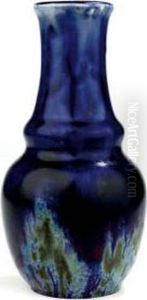Adrien Pierre Dalpayrat Paintings
Pierre-Adrien Dalpayrat, commonly known as Adrien Dalpayrat, was a notable French ceramist born on December 16, 1844, in Limoges, a city internationally renowned for its porcelain. His initial training was not in ceramics but rather in drawing and painting; however, he later shifted his focus towards the art of pottery, which he pursued with great passion and innovation.
Dalpayrat started his career as a faience painter in Tarbes, after which he moved to Paris in 1867. There, he worked in various capacities for several companies before establishing his own studio in 1889 in Bourg-la-Reine, a suburb of Paris. It was in this studio that Dalpayrat began to truly flourish as a ceramist, becoming famous for his unique stoneware pieces.
He is best known for his mastery of the sang de boeuf glaze, or 'oxblood' glaze, a complex and difficult technique that originated in China and was highly prized during the Ming dynasty. Dalpayrat's work with this glaze was distinctive due to the rich and varied shades of red and the subtle transitions to greens and blues that he managed to achieve. His glazes, often featuring flambé effects, would become his signature and were known as 'Dalpayrat red.'
Dalpayrat collaborated with a number of artists and sculptors, such as Alphonse Voisin-Delacroix and Ernest Carrière, to create innovative shapes and decorations that complemented his glazes. His works were often organic in form, drawing inspiration from nature, with many pieces evocative of plants, animals, and the human figure, which were popular motifs in the Art Nouveau movement.
His ceramics were exhibited at various expositions, including the Exposition Universelle in Paris in 1889 and 1900, where he received critical acclaim and solidified his reputation as a leading figure in the field of ceramic arts. Despite his success, Dalpayrat preferred to keep his production on a small scale, focusing on the artistic quality of his work rather than mass production.
Adrien Dalpayrat passed away on February 25, 1910, in Bourg-la-Reine. His legacy lives on through his innovative glazes and forms, which had a significant impact on the Art Nouveau movement and continue to be celebrated in the art world. His works are collected and displayed in many museums around the globe, including the Musée d'Orsay in Paris and the Metropolitan Museum of Art in New York.
